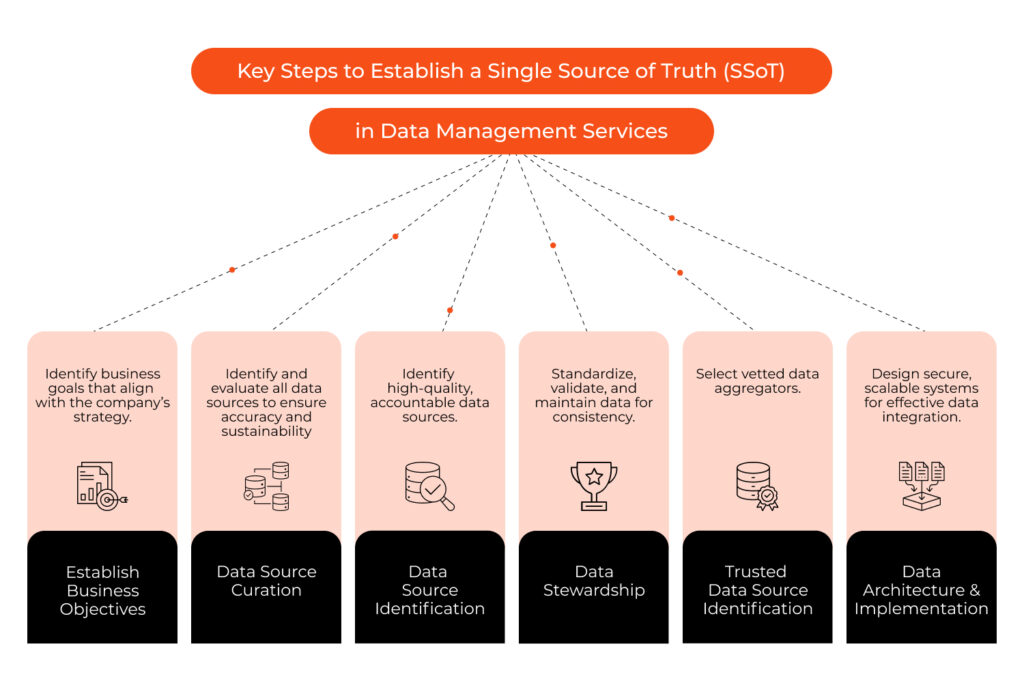Data and People Collaborating: Are They the True Drivers of Data Management Services?

Today we believe that data is power, a non-negotiable, strategic asset for business to drive growth and efficiency. However, the real question lies in whether data is the only driver of success or is it data and people collaborating that truly makes the difference?
Data is, essentially, the center of a successful data management service journey, however, at the core of this quest are people. People who must communicate with each other to achieve short and long-term business goals.
What is Data Management?
Data management is a step-by-step process of collecting, storing, processing, and analyzing data. It includes various technologies, methodologies, and best practices to ensure data integrity, accessibility, and security. The effectiveness of data management services is not only dependent on technology or data, but it is profoundly influenced by the collaboration between data and people. Therefore, this symbiotic relationship between data and humans defines the success of any data management services.
To be able to transform the collected data into actionable insights is what drives efficient decision-making, innovation, and competitive advantage.
Data management services that are not strongly aligned with the company and its process will find it tough to stay competitive and drive growth. The enterprise provides the use cases, and goals, and technology helps scale it. The success of a data management service initiative strongly depends on a smooth alliance. To achieve this, we need people to steward, architect, develop, and govern data transformation. This is where the people, policies, processes, and technology intersect to define data management.
Role of Data in Data Management Services
Data as a Single Source of Truth (SSoT)
While the primary goal is to drive value, it always aids if the enterprise has a data-driven culture. This can only happen if the data is established as a single source of truth. However, implementing SSoT requires a structured approach that integrates data strategy, data governance, and data management services.
The success of a single source of truth in data-driven enterprises within the data management services depends on logic, governance, and alignment with enterprise goals. Only a well-executed data strategy can ensure an actionable, accurate, and dependable data set.
Challenges in Managing Data
Bad Data
According to a study in the Harvard Business Review, 50% of people working with data are wasting their time hunting for data, finding and correcting errors, and searching for confirmatory sources for the data they don’t trust!
What is bad data? In common terms, it’s data that is incomplete, inaccurate, duplicate, or outdated. Implementing data harmonization and unification through AI and ML models companies can prevent this bad data from entering the system and prevent disruptions.
Understanding Data
According to a survey conducted by Capital One on data management challenges, 76% of companies found it difficult to understand their data. Without clarity, companies faced risks in utilizing data for valuable insights. Implementing advanced data visualization tools through self-service BI implementation is crucial to getting real-time insights for better decision-making and inventory management.
Data Silos
Enterprises sometimes have varied sources of data. To be able to manage them under one system can be difficult. Without a centralized framework, businesses struggle with inefficient and inaccurate data reporting. Implementing data integration solutions can help consolidate and harmonize the data, providing a single unified view for better decision making.
Integration of AI Technologies
By deploying AI and ML in data management cycles, companies can automate data collection, cleaning, and analytics directly into their supply chain management. AI can drive real-time insights by identifying patterns to predict potential disruptions, identify bad data, and ensure accuracy.
Role of People in Data Management Services
Human intervention is undebatable in establishing a thriving data management system. Individuals play a crucial role in converting raw data into real-time insights. Efficient data management teams consist of the following roles:
- Database Administrators (DBAs): Organize and maintain databases, along with ensuring system performance and security.
- Data Architects: Develop data storage and access frameworks efficiently.
- Data Modelers: Develop conceptual, logical, and physical models to organize organizational data.
Human Insight in Governance
Although automation is key to current governance systems, human supervision cannot be overlooked. Ethics or contextual-based decisions—experimental healthcare procedures, for instance—are left to human discretion. Individuals dictate data governance priorities to support business goals and still comply with regulations.
The Collaborative Power of Data and Humans
Data management services that work well encompass several practices that include data gathering, storing, governance, and analytics. Even though technology enables it, human intervention is equally important to ensure data quality, implement governance and compliance, and drive decision-making.
Encouraging Collaboration
Cross-Team Synergy
Enable collaboration among technical teams (data engineers) and domain experts (business users). This helps ensure insights from common datasets remain relevant and eliminate data silos. For example, marketing teams can benefit from financial data to optimize campaign budgets, while finance teams can use customer insights to improve revenue forecasting. This integration helps businesses maximize their data's potential and ensures that decisions are based on a holistic view of operations.
Training Programs
Establish training programs for members who are not familiar with advanced tools to enhance adoption ratios. Decision makers must have the knowledge to question and validate data insights and promote a data-driven decision-making culture.
Integrating Technology
Use version control systems to avoid conflicts when multiple teams work on shared datasets. Deploy AI/ML tools for automating repetitive tasks like compliance checks while ensuring human oversight for critical decisions.
According to the McKinsey 2025 report, almost all companies invest in AI, while only 1% of business leaders believe they are at the maturity of deploying AI into their current systems. So, where does your organization stand?
Conclusion
AI and ML have revolutionized data management by automating repetitive tasks, identifying patterns, and predicting outcomes. However, collaboration between humans and data forms the backbone of successful data management services.
Technology enables the storage, processing, and analysis of great volumes of data, but human expertise is what turns this information into strategies aimed at organizational objectives.
Syren’s AI-powered solutions enable seamless human-AI collaboration for optimal data management outcomes. Ready to optimize your data management strategy? Let Syren help you take control of your data with AI-driven solutions and expert governance. Contact us today!



